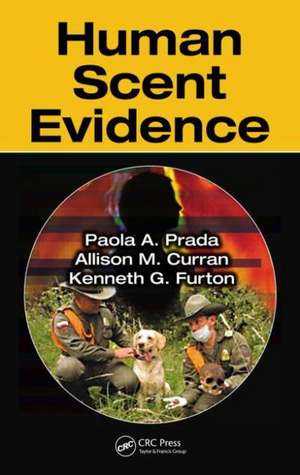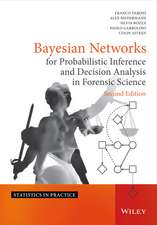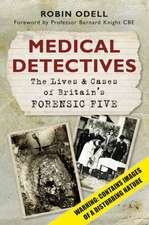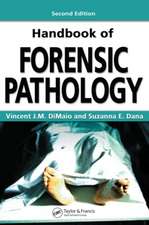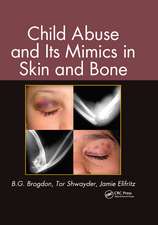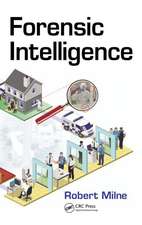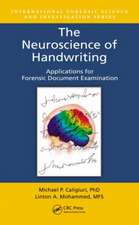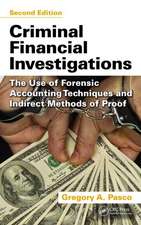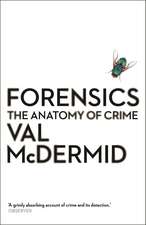Human Scent Evidence
Autor Paola A. Prada, Allison M. Curran, Kenneth G. Furtonen Limba Engleză Hardback – 14 oct 2014
- Various theories of human odor production
- The variability, stability, and persistence of human scent
- Historical aspects of the use of human scent in police work in the United States and internationally
- Current trends in scent collection techniques, including devices, materials, and storage protocols
- Chemical aspects of the evaluation of human scent, including instrumental methods for odor detection and analysis
- The legal significance of human scent evidence results
- Canine scent work from multiple search categories as described in the Scientific Working Group on Dog and Orthogonal detector Guidelines (SWGDOG)
| Toate formatele și edițiile | Preț | Express |
|---|---|---|
| Paperback (1) | 384.60 lei 6-8 săpt. | |
| Taylor & Francis – 31 mar 2021 | 384.60 lei 6-8 săpt. | |
| Hardback (1) | 764.62 lei 6-8 săpt. | |
| Taylor & Francis – 14 oct 2014 | 764.62 lei 6-8 săpt. |
Preț: 764.62 lei
Preț vechi: 1103.04 lei
-31% Nou
Puncte Express: 1147
Preț estimativ în valută:
146.33€ • 158.89$ • 122.91£
146.33€ • 158.89$ • 122.91£
Carte tipărită la comandă
Livrare economică 22 aprilie-06 mai
Preluare comenzi: 021 569.72.76
Specificații
ISBN-13: 9781466583955
ISBN-10: 1466583959
Pagini: 228
Ilustrații: 55 black & white illustrations, 20 colour illustrations, 2 black & white tables
Dimensiuni: 156 x 234 x 18 mm
Greutate: 0.48 kg
Ediția:1
Editura: Taylor & Francis
Colecția CRC Press
Locul publicării:Oxford, United Kingdom
ISBN-10: 1466583959
Pagini: 228
Ilustrații: 55 black & white illustrations, 20 colour illustrations, 2 black & white tables
Dimensiuni: 156 x 234 x 18 mm
Greutate: 0.48 kg
Ediția:1
Editura: Taylor & Francis
Colecția CRC Press
Locul publicării:Oxford, United Kingdom
Public țintă
Academic and Professional Practice & DevelopmentCuprins
Introduction and Historical Perspectives. Production of Human Scent. Chemical Composition of Human Scent: A Volatile Perspective. Variability of Human Scent. Collection of Human Scent as Forensic Evidence. Persistence and Stability of Human Scent. Human Scent Canines. Future Biometric and Diagnostic Applications. Appendix A: Argentina Human Scent Evidence Standard Operating Procedures. Appendix B: Finnish Regulations for Scent Identification. Appendix C: SWGDOG SC2—General Guidelines. Appendix D: SWGDOG SC8— Substance Detector Dogs. Appendix E: SWGDOG SC9— Human Scent Dogs. Index.
Notă biografică
Paola A. Prada, Ph.D., is an intelligence community postdoctoral research fellow. Her studies encompass interdisciplinary areas such as chemistry, animal behavior, and national security to address issues that are critical to effective intelligence and defense capabilities. She has worked extensively on developing instrumental methods for human odor identification for criminal investigations. Dr. Prada has also worked with canine scent detection in the context of optimizing odor collection techniques for scent training.
Kenneth G. Furton, Ph.D., is a professor in the Department of Chemistry and Biochemistry and Dean of the College of Arts and Sciences at Florida International University. His research has focused on the canine and instrumental detection of accelerants, biotoxins, currency, drugs, explosives, and humans (dead and alive). Dr. Furton’s expertise in forensic science has been sought by the legal system for which he has testified dozens of times as an expert witness in state and federal courts.
Kenneth G. Furton, Ph.D., is a professor in the Department of Chemistry and Biochemistry and Dean of the College of Arts and Sciences at Florida International University. His research has focused on the canine and instrumental detection of accelerants, biotoxins, currency, drugs, explosives, and humans (dead and alive). Dr. Furton’s expertise in forensic science has been sought by the legal system for which he has testified dozens of times as an expert witness in state and federal courts.
Descriere
During the last decade, scientific studies have supported using human scent as a biometric tool and indicator of the presence or absence of an individual at a crime scene. This book focuses on some of these recent advances in the use of human scent as forensic evidence. It examines theories of human odor production, the legal significance of results, and canine scent work from multiple search categories as described in the Scientific Working Group on Dog and Orthogonal detector Guidelines (SWGDOG). It also explores current trends in scent collection techniques, including devices, materials, and storage protocols.
